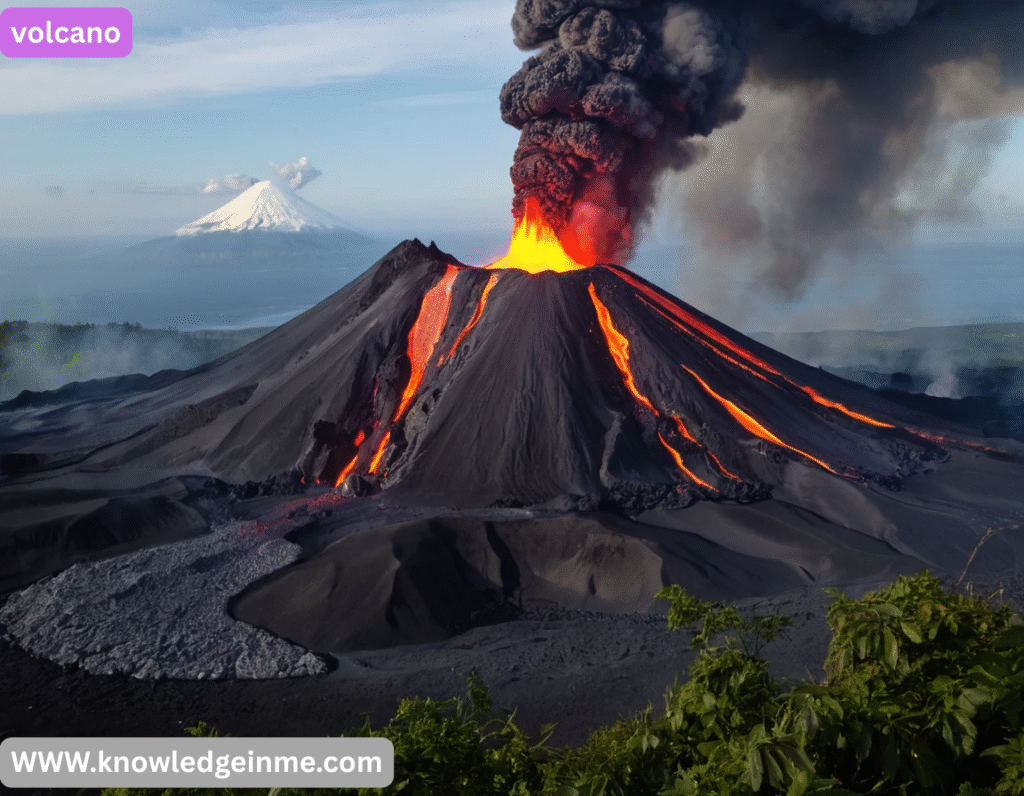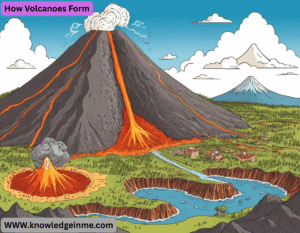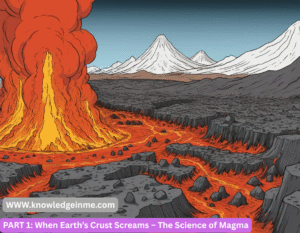volcano Volcanoes are typically found where tectonic plates diverge or converge, and they can form both on land and underwater.
Key Features of a Volcano
- Vent – The opening through which volcanic material erupts.
- Crater – A bowl-shaped depression at the summit.
- Lava – Molten rock that flows out during an eruption.
- Ash & Pyroclastic Flow – Fast-moving currents of hot gas and volcanic matter.
Types of Volcanoes
- Shield Volcanoes (e.g., Mauna Loa, Hawaii) – Broad, gently sloping sides formed by basaltic lava flows.
- Stratovolcanoes (Composite) (e.g., Mount Fuji, Japan) – Steep, conical, with explosive eruptions due to viscous magma.
- Cinder Cone Volcanoes (e.g., PARICUTIN, Mexico) – Small, steep-sided, formed from ejected fragments.
- Super volcanoes (e.g., Yellowstone Caldera) – Capable of massive, catastrophic eruptions.
Effects of Volcanic Eruptions
- Positive: Fertile soil, geothermal energy, new land formation.
Famous Volcanic Eruptions
- Mount Vesuvius (79 AD) – Destroyed Pompeii and Herculaneum.
- Krakatoa (1883) – One of the deadliest, causing global cooling.
- Mount St. Helens (1980) – Major eruption in the U.S.
- Eyjafjallajökull (2010) – Disrupted European air travel.
How Volcanoes Form
Volcanoes are primarily created by plate tectonics:
- Divergent Boundaries (e.g., Mid-Atlantic Ridge) – Plates pull apart, magma rises to fill the gap.
- Convergent Boundaries (e.g., Pacific Ring of Fire) – One plate subducts beneath another, melting into magma.
- Hotspots (e.g., Hawaii) – Mantle plumes melt through the crust, forming volcanoes away from plate edges.
Types of Volcanic Eruptions
Eruptions vary based on magma viscosity (stickiness) and gas content:
Eruption Type Characteristics Example
Hawaiian Gentle lava flows, low viscosity KILAUEA, Hawaii
Strombolian Frequent explosions, lava fountains Stromboli, Italy
VULCANIAN Short, violent bursts, ash clouds Sakurajima, Japan
Plinian Catastrophic, column of ash & pumice Mount Vesuvius (79 AD)
SURTSEYAN Explosive underwater eruptions SURTSEY, Iceland
Volcanic Hazards
- Pyroclastic Flows – Deadly superheated ash & gas (500–1,000°C, speeds up to 700 km/h).
- Volcanic Ash – Can collapse roofs, disrupt aviation, and cause respiratory issues.
- Lahars – Mudflows from melted snow/rain mixed with ash (e.g., NEVADO del Ruiz, 1985 – killed ~25,000).
- Volcanic Gases (CO₂, SO₂) – Can suffocate life (Lake NYOS disaster, 1986) or cause acid rain.
Benefits of Volcanoes
- Fertile Soil – Volcanic ash enriches land (e.g., vineyards near Mount Etna).
- Geothermal Energy – Used in Iceland & New Zealand for clean power.
- New Land Formation – Islands like SURTSEY (Iceland) and NISHINOSHIMA (Japan) were born from eruptions.
- Mineral Resources – Gold, silver, diamonds, and copper are often found near volcanic areas.
Super volcanoes & Their Global Impact
- These can cause mass extinctions and volcanic winters by releasing thousands of cubic kilometers of material.
- Yellowstone Caldera (USA) – Last erupted ~640,000 years ago; if it erupts again, it could block sunlight for years.
- Toba (Indonesia, ~74,000 years ago) – Nearly wiped out early humans; caused a 6-year volcanic winter.
Unusual & Extreme Volcanoes
- Olympus Mons (Mars) – Tallest volcano in the solar system (22 km high, 3x Everest!).
- Cryovolcanoes (Ice Volcanoes) – Erupt water/ammonia instead of lava (found on Saturn’s moon Enceladus).
- Lava Lakes – Rare persistent molten lava pools (e.g., NYIRAGONGO, DR Congo).
Predicting Volcanic Eruptions
Scientists monitor:
- Earthquakes (increasing tremors)
- Ground Deformation (bulging from magma)
- Gas Emissions (changes in SO₂/CO₂ levels)
- Thermal Imaging (heat spikes)
Despite advances, eruptions can still be unpredictable (e.g., 2019 Whakaari/White Island disaster in NZ).
Extremely Rare & Bizarre Volcanic Phenomena
- Blue Lava (KAWAH IGEN, Indonesia)
- Caused by burning sulfuric gas (up to 600°C), creating an eerie blue glow at night.
- Miners extract sulfur here, facing toxic fumes.
Underwater Black Smokers
- Hydrothermal vents spewing superheated, mineral-rich water (350°C+).
- Host extremophile lifeforms (giant tube worms, chemosynthetic bacteria).
Volcanic Lightning
- Seen in eruptions like 2010 Eyjafjallajökull (Iceland) and TAAL Volcano (Philippines, 2020).
Lava Tubes
- Natural tunnels formed by cooling lava crusts while molten lava flows beneath.
- Future use: Potential shelters for Moon/Mars colonies!
How Volcanoes Influence Global Climate
- Cooling Effect (Volcanic Winter)
- Sulfur dioxide (SO₂) converts to sulfate aerosols, reflecting sunlight.
Examples
- 1815 TAMBORA eruption → “Year Without a Summer” (global famine).
- Warming Effect (CO₂ Release)
- Over geologic time, volcanoes emit CO₂, contributing to greenhouse warming.
- Deccan Traps (India, 66 million years ago) may have worsened the K-T extinction event.
“Volcanic vs. Human” CO₂ Comparison
Source CO₂ Emissions (per year)
All Volcanoes ~0.3 billion tons
Human Activity 40 billion tons
→ Humans emit 100x more CO₂ than volcanoes!
Most Dangerous Active Volcanoes Today
Yellowstone Super volcano (USA)
If it erupts, it could plunge Earth into a decade-long winter.
- Current status: Dormant, but monitored closely.
CAMPI FLEGREI Italy
- A super volcano near Naples (more dangerous than Vesuvius!).
- Shows signs of rising magma (could threaten 1.5 million people).
POPOCATEPETI Mexico
- Near Mexico City (25 million people at risk).
- Frequent ash eruptions since 1994.
TAAL Philippines
- One of the deadliest due to proximity to Manila.
- 2020 eruption caused mass evacuations.
NYIARGONGO DR Congo
- Fastest lava flows on Earth (60+ mph).
- 2021 eruption destroyed homes in Goma.
How Life Survives Near Volcanoes
- Extremophiles (Life in Hellish Conditions)
- Thermophiles (heat-loving bacteria) thrive in hot springs (e.g., Yellowstone).
- ACIDOPHILES survive in pH < 3 (e.g., Río Tinto, Spain).
Human Adaptations
- Indonesia & Japan: Farmers use volcanic soil for ultra-fertile crops (rice, coffee, wine).
- Iceland: Geothermal energy heats 90% of homes.
Disaster Preparedness
- Early warning systems (seismic sensors, gas monitors).
- Evacuation drills (e.g., Sakurajima, Japan).
Futuristic Volcanic Research & Exploration
Predicting Eruptions with AI
- Machine learning analyzes seismic data for eruption patterns.
- NASA’s Earth Observing System tracks volcanic gases from space.
Volcanoes on Other Planets
- Venus: Possibly active (recent lava flows detected).
PART 1: When Earth’s Crust Screams – The Science of Magma
The Blood Types of Lava
- PAHOEHOE (Hawaiian “smooth”): Ropey, fast-moving lava (like hot syrup).
- ‘A.A (Hawaiian “stony”): Jagged, spiky lava that crunches when you walk on it.
- Pillow Lava: Forms underwater in blob-like shapes (common at mid-ocean ridges).
- Why Some Volcanoes Go BOOM and Others Just Ooze
- High Silica Magma (e.g., Mt. St. Helens): Thick like peanut butter → traps gas → KABOOM!
- Low Silica Magma (e.g., KILAUEA): Runny like olive oil → gas escapes → peaceful lava flows.
PART 2: History’s Most Brutal Eruptions – Apocalypses That Reshaped Civilization
- Thera (Santorini), 1600 BCE
- Obliterated the Minoan civilization → may have inspired the Atlantis legend.
- Ash found in Egyptian tombs from this era.
- TAMBORA, 1815 (“The Year Without Summer”)
Krakatoa, 1883
- Heard 3,000 miles away (loudest sound in recorded history).
- Caused a tsunami with waves 120 feet high.
- Toba Super eruption, 74,000 Years Ago
- Nearly wiped out humans → some scientists think only 3,000 survivors remained.
PART 4: The Future of Volcanoes – Can We Tame Them
- Artificial Cooling: Pumping Water into Magma Chambers?
- Risky experiment to prevent super volcano eruptions by slowly releasing pressure.
- Could backfire and trigger the very explosion we fear.
- Volcanic Energy Mining
- Drilling into magma for unlimited geothermal power (Iceland is already testing this).






